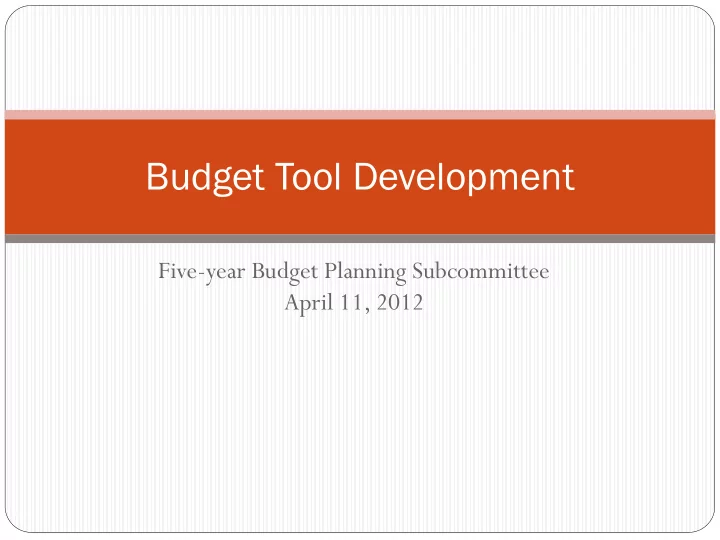

Budget Tool Development Five-year Budget Planning Subcommittee April 11, 2012
Setting priorities – Typical Challenges Our understanding of complex health / population systems is limited Qualitative attributes (values, mission, ethics, and equity) are difficult to combine with quantitative attributes (e.g., burden of disease) Inclusion of diverse stakeholders with competing interests / values Goals, criteria, or alternatives to be prioritized are not always well specified Timely decisions must be made, sometimes with limited evidence Ideal analyses are not complete, timely, or feasible Our understanding of prioritization methods may be limited Criteria may have different measurement scales or no scale at all
Setting priorities - Informal methods Organizational traditions Leadership preferences Politics and advocacy Categorical funding
Setting priorities - Formal methods Conduct a needs assessment Define “core” services Conduct economic evaluations (e.g., Cost-benefit Analysis, Cost-effectiveness Analysis) Conduct multi-criteria decision-making (MCDM) process Program Budgeting and Marginal Analysis (PBMA) combined with MCDM
Proposed methods: PMBA + AHP Program Budgeting and Marginal Analysis Use program budgeting approach Apply economic concepts: considers opportunity costs and uses marginal analysis Apply criteria to prioritize programs based on marginal benefits and costs (see AHP) Analytic Hierarchy Process (AHP) Most common MCDM method in the world Has many uses: decision making, priority setting, resource allocation, prediction, planning, etc.
Proposed Budget Tool Framework Based upon • Analytic Hierarchy Process (AHP); and • Program Budgeting and Marginal Analysis (PBMA) • • Analysis tool that aids provides insight into complex problems by incorporating qualitative and quantitative decision criteria • Information is decomposed into a hierarchy of alternatives and criteria • Information is then synthesized to determine relative ranking of alternatives • Both qualitative and quantitative information can be compared using informed judgments to derive weights and priorities • Seven step process
Seven-Step Process Define the problem or opportunity 1. e.g., need to determine budget priorities in the face of budget reductions Determine goal of AHP 2. e.g., prioritize current and proposed service modalities Develop criteria 3. e.g., what is important and why? Organize criteria 4. e.g., how are the criteria related to one another? (hierarchy) Weight criteria 5. e.g., are some criteria more important than others? Rank alternatives using criteria 6. e.g., tool is applied to prioritize service modalities Conduct sensitivity analysis 7. e.g., which inputs had largest effects on outputs?
Analytic Hierarchy Process (1/2) Goal Criterion Criterion Criterion 1 2 3 Alternative Alternative Alternative Alternative A B C D
Analytic H tic Hierar rarch chy P Process (2/2) 2) Prioritize Modalities Strategic Health Organizational Alignment Impact Impact Modality Modality Modality Modality A B C D
DecisionLens http://www.youtube.com/watch?v=FoAomdhOT3k&featu re=email
Sample Tool
Sample Tool (cont.)
Sample Tool (cont.)
Recommend
More recommend